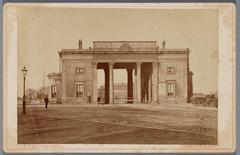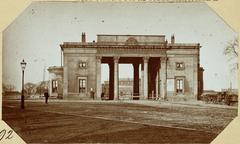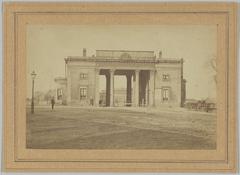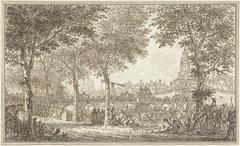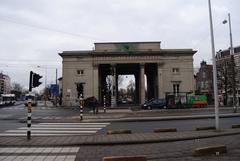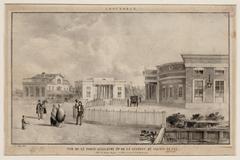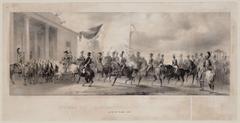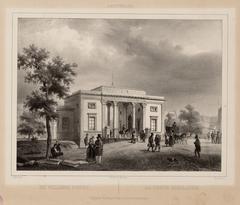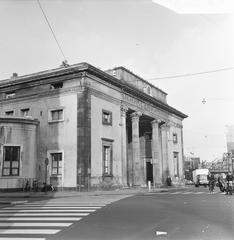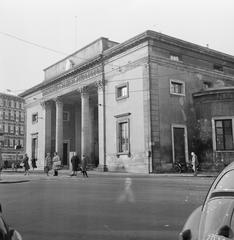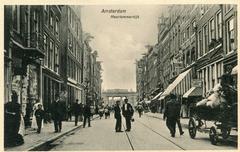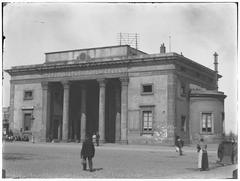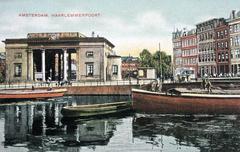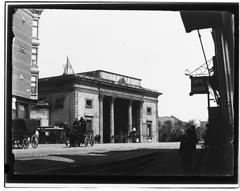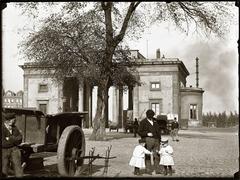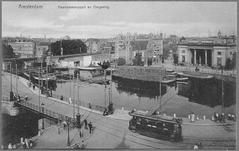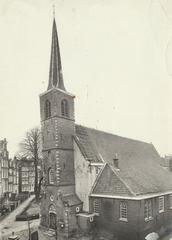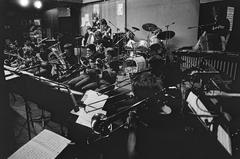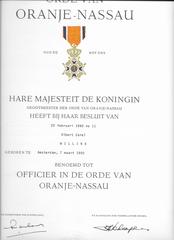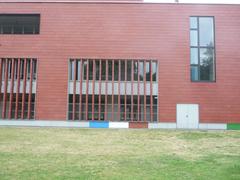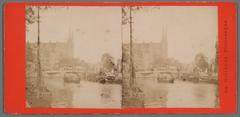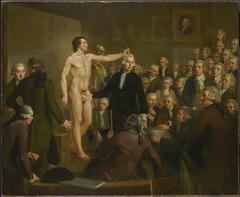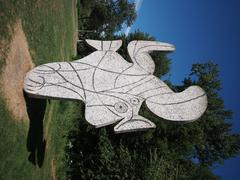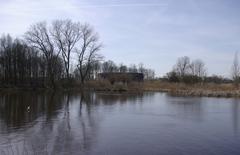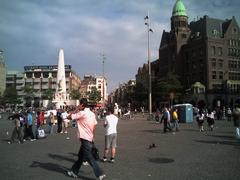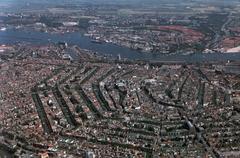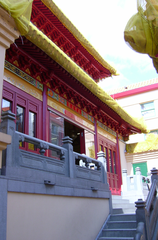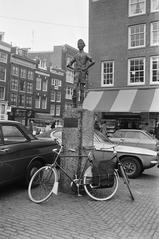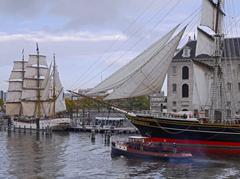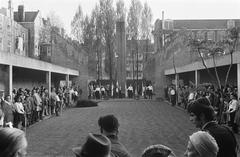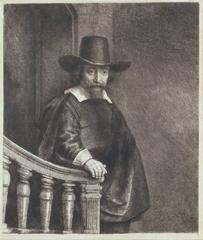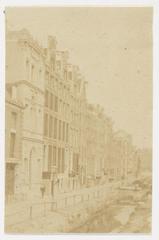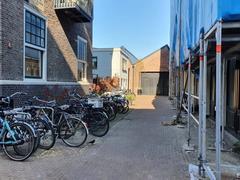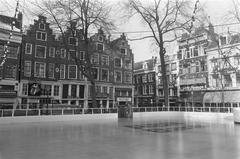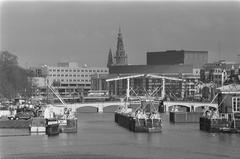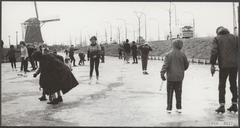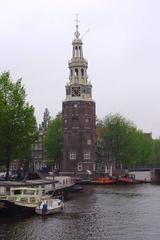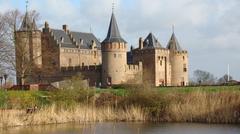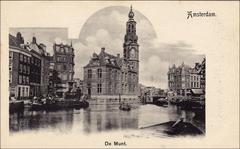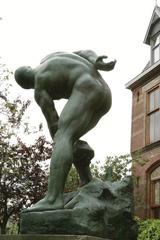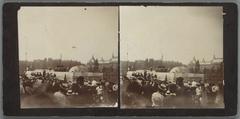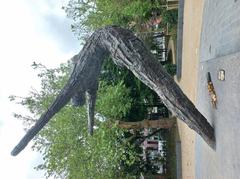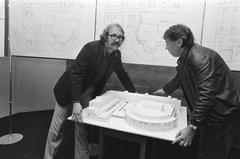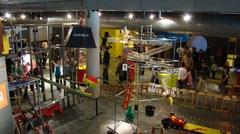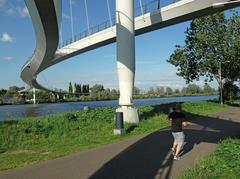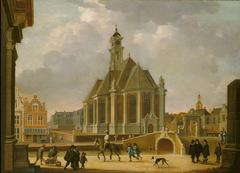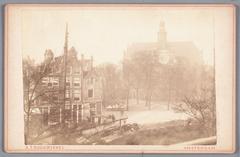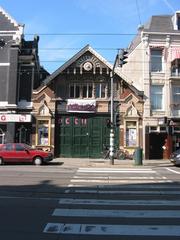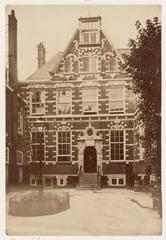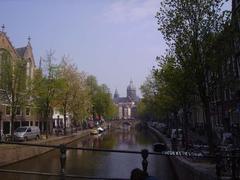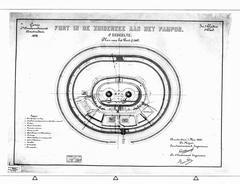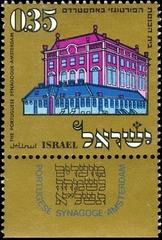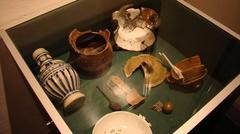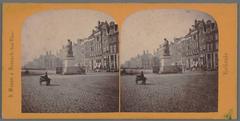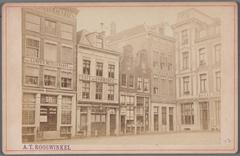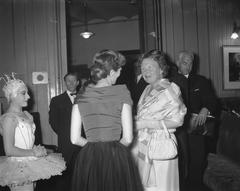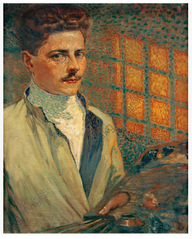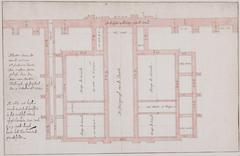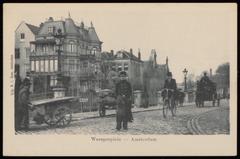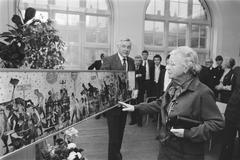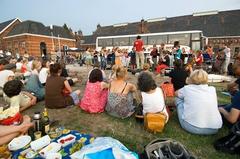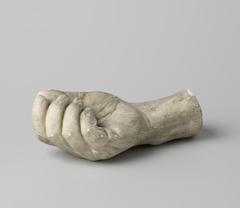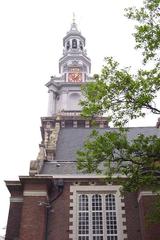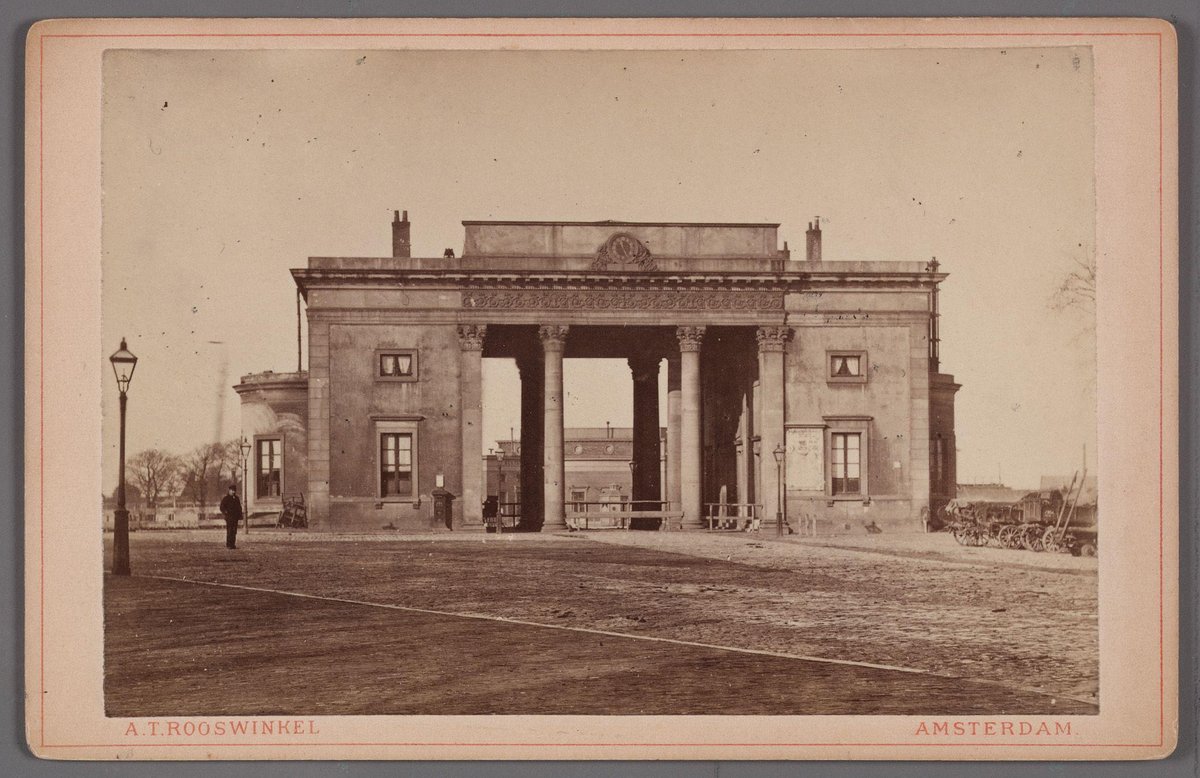
Visiting Hours and Ticket Information for Haarlemmerpoort, Amsterdam
Date: 31/07/2024
Overview of Haarlemmerpoort
Amsterdam’s Haarlemmerpoort, also known as the Willemspoort, is a historic city gate that stands as a testament to the city’s rich architectural and cultural heritage. Originally constructed in 1618, Haarlemmerpoort has undergone several transformations, each reflecting the evolving priorities and styles of different eras. From its early beginnings as a wooden gate to its neoclassical redesign in the 19th century by architect Cornelis Alewijn, Haarlemmerpoort has played a significant role in the city’s defense, commercial, and cultural activities (mforamsterdam.com). Today, it serves as a vibrant landmark, housing businesses and cultural organizations while preserving its historical integrity (lonelyplanet.com). This comprehensive guide aims to provide visitors with essential information, including visiting hours, ticket prices, travel tips, and nearby attractions, ensuring a memorable experience at this iconic Amsterdam monument.
Discover the Historical Haarlemmerpoort: Visiting Hours, Tickets, and Architectural Significance in Amsterdam
Introduction
Haarlemmerpoort, also known as the Willemspoort, is one of the historical city gates of Amsterdam. This article will delve into its rich history, architectural significance, and provide essential visitor information, including ticket prices, visiting hours, and travel tips to enhance your experience. Discover why this landmark remains a vibrant part of Amsterdam’s heritage.
Early Beginnings
Haarlemmerpoort, originally constructed in 1618 as part of the city’s expansion efforts, started as a simple wooden gate. Serving as a checkpoint for goods and people entering from the west, it was named after the city of Haarlem. This early structure laid the foundation for what would become a significant historical site.
The 17th Century: First Stone Gate
In 1618, the wooden gate was replaced by a more durable stone structure. This new gate was integral to the city’s defensive walls, reflecting Amsterdam’s growing importance as a commercial hub in the 17th century.
The 19th Century: Neo-Classical Redesign
By the early 19th century, the stone gate had deteriorated. In 1837, architect Cornelis Alewijn redesigned it in a neoclassical style. Completed in 1840, the new Haarlemmerpoort featured columns and a pediment, embodying the architectural trends of the time.
20th Century: Decline and Restoration
Throughout the 20th century, Haarlemmerpoort faced neglect. By the mid-century, it was in disrepair, leading to restoration efforts in the 1970s to stabilize and preserve its historical features.
21st Century: Modern Use and Preservation
Today, Haarlemmerpoort houses various businesses and cultural organizations, maintaining its historical integrity while serving modern purposes. Restoration efforts have preserved it as a significant historical landmark in Amsterdam.
Architectural Significance
Haarlemmerpoort is a prime example of neoclassical architecture in Amsterdam. Its design reflects the influence of ancient Greek and Roman architecture, symbolizing Amsterdam’s historical importance as a commercial and cultural center.
Cultural and Historical Importance
Beyond its architectural beauty, Haarlemmerpoort holds cultural and historical significance, witnessing centuries of Amsterdam’s evolution. Its preservation reflects the city’s commitment to its heritage while adapting to contemporary needs.
Visitor Information
- Visiting Hours: Haarlemmerpoort is accessible to the public daily. Check the official Amsterdam tourism website for the latest visiting hours.
- Tickets: Entry to Haarlemmerpoort is free. However, guided tours may have associated costs. Refer to the official website for detailed information on tour prices and bookings.
- Special Events: The gate occasionally hosts cultural events and exhibitions. Check the website for upcoming events.
- Guided Tours: Enhance your visit with guided tours that provide in-depth historical and architectural insights.
Visitor Tips
- Photography: The gate’s neoclassical design makes it a popular spot for photography. Early morning or late afternoon light offers the best conditions for capturing its details.
- Nearby Attractions: Combine your visit with nearby sites like the Anne Frank House or the Jordaan district for a more comprehensive experience of Amsterdam’s historical sites.
- Accessibility: Easily accessible by public transportation, with several tram and bus lines stopping nearby. Check local transit schedules for the most convenient routes.
FAQ
- What are the visiting hours for Haarlemmerpoort?
- Haarlemmerpoort is open daily. Check the official Amsterdam tourism website for the latest visiting hours.
- How much are the tickets for Haarlemmerpoort?
- Entry is free. Guided tours may have associated costs, which can be found on the official website.
- What nearby attractions can I visit?
- Nearby attractions include the Anne Frank House and the Jordaan district.
Conclusion
Haarlemmerpoort stands as a testament to Amsterdam’s rich history and architectural heritage. From its early beginnings as a wooden gate to its current status as a preserved historical landmark, the gate reflects the city’s evolution over centuries. Visitors can appreciate its architectural beauty, historical significance, and the dedicated efforts to preserve this important piece of Amsterdam’s heritage.
For more information on Haarlemmerpoort and other historical landmarks in Amsterdam, visit the official Amsterdam tourism website.
Explore Haarlemmerpoort: Visitor Tips, History, and Nearby Attractions in Amsterdam
Understanding Haarlemmerpoort
Haarlemmerpoort, also known as the Willemspoort, is a historic city gate located in Amsterdam. It is one of the few remaining gates from the city’s old fortifications. Built in 1840, it stands as a testament to Amsterdam’s rich architectural and historical heritage. The gate was designed by architect Cornelis Alewijn and is a fine example of neoclassical architecture.
Best Time to Visit Haarlemmerpoort
Amsterdam experiences a temperate maritime climate, which means mild summers and cool winters. The best time to visit Haarlemmerpoort is during the late spring (May to June) and early autumn (September to October) when the weather is pleasant, and the tourist crowds are relatively smaller. Summer (July to August) is also a good time, but be prepared for larger crowds and higher prices.
Getting There
Haarlemmerpoort is conveniently located near the city center, making it easily accessible by various modes of transportation:
- By Bike: Amsterdam is a bike-friendly city with numerous bike rental shops. Cycling to Haarlemmerpoort is a scenic and eco-friendly option.
- By Public Transport: The nearest tram stop is Haarlemmerplein, served by tram lines 3 and 5. From there, it’s a short walk to the gate.
- By Foot: If you’re staying in the city center, Haarlemmerpoort is within walking distance. It’s a great way to explore the surrounding neighborhoods.
Nearby Attractions
While visiting Haarlemmerpoort, consider exploring these nearby attractions:
- Westerpark: A large urban park perfect for a leisurely stroll or a picnic. It also hosts various cultural events and festivals throughout the year.
- Jordaan District: Known for its narrow streets, quaint cafes, and boutique shops, the Jordaan is a charming neighborhood to explore.
- Anne Frank House: Located a short distance away, this museum offers a poignant glimpse into the life of Anne Frank and the history of World War II.
Guided Tours of Haarlemmerpoort
For a more in-depth understanding of Haarlemmerpoort and its historical significance, consider joining a guided tour. Several tour operators offer walking tours that include Haarlemmerpoort as part of their itinerary. These tours often provide valuable insights and anecdotes that you might miss on a self-guided visit.
Photography Tips
Haarlemmerpoort is a photogenic landmark, especially during the golden hours of sunrise and sunset. Here are some tips for capturing the best shots:
- Golden Hour: The soft, warm light during the golden hour enhances the architectural details of the gate.
- Wide-Angle Lens: Use a wide-angle lens to capture the entire structure and its surroundings.
- Symmetry: The neoclassical design of Haarlemmerpoort lends itself well to symmetrical compositions.
Safety Tips
While Amsterdam is generally a safe city, it’s always wise to take precautions:
- Watch for Cyclists: Amsterdam’s cycling culture is vibrant, and cyclists have the right of way. Be mindful of bike lanes and always look both ways before crossing.
- Secure Your Belongings: Pickpocketing can occur in crowded areas. Keep your belongings secure and be aware of your surroundings.
- Respect Local Customs: Amsterdam locals value their privacy and space. Be respectful and avoid loud or disruptive behavior.
Accessibility
Haarlemmerpoort is accessible to visitors with mobility issues. The surrounding area is relatively flat, and there are no significant barriers to entry. However, it’s always a good idea to check with local authorities or tour operators for specific accessibility information.
Local Etiquette
When visiting Haarlemmerpoort and other historical sites in Amsterdam, it’s important to observe local etiquette:
- Quiet Reflection: Historical sites often hold significant cultural and emotional value. Maintain a respectful demeanor and avoid loud conversations.
- No Littering: Help keep Amsterdam clean by disposing of trash in designated bins.
- Photography: While photography is generally allowed, be mindful of other visitors and avoid using flash in sensitive areas.
Dining Options Near Haarlemmerpoort
After exploring Haarlemmerpoort, you might want to grab a bite to eat. Here are some nearby dining options:
- Café Restaurant Amsterdam: Located in a former water pumping station, this restaurant offers a unique dining experience with a diverse menu.
- Winkel 43: Famous for its apple pie, Winkel 43 is a cozy café located in the Jordaan district.
- Pikoteo: A trendy tapas bar offering a variety of small plates and cocktails, perfect for a casual meal.
Shopping Near Haarlemmerpoort
If you’re in the mood for shopping, the Haarlemmerdijk and Haarlemmerstraat streets are nearby and offer a variety of shops, from fashion boutiques to specialty stores. These streets are known for their unique and independent shops, making them a great place to find souvenirs and gifts.
Events and Festivals Near Haarlemmerpoort
Amsterdam hosts numerous events and festivals throughout the year, many of which take place near Haarlemmerpoort:
- Grachtenfestival: Held in August, this classical music festival features performances along Amsterdam’s canals. (Grachtenfestival)
- De Parade: A traveling theater festival that sets up in various parks around the city, including nearby Westerpark. (De Parade)
Practical Information for Visiting Haarlemmerpoort
- Opening Hours: Haarlemmerpoort is accessible 24/7, but it’s best to visit during daylight hours for safety and better visibility.
- Admission Fee: There is no admission fee to visit Haarlemmerpoort.
- Facilities: There are no specific facilities at Haarlemmerpoort, but nearby parks and cafes offer restrooms and refreshments.
FAQs About Haarlemmerpoort
- What are the visiting hours for Haarlemmerpoort? Haarlemmerpoort is accessible 24/7, though daytime visits are recommended for safety and visibility.
- Is there an admission fee for Haarlemmerpoort? No, there is no admission fee to visit Haarlemmerpoort.
- Are there any guided tours available? Yes, several tour operators offer guided walking tours that include Haarlemmerpoort as part of their itinerary.
- What are some nearby attractions? Nearby attractions include Westerpark, the Jordaan District, and the Anne Frank House.
Final Tips for Your Visit to Haarlemmerpoort
- Weather: Amsterdam’s weather can be unpredictable. Pack layers and be prepared for rain, even in the summer.
- Language: While Dutch is the official language, English is widely spoken, making it easy for tourists to communicate.
- Currency: The currency used in Amsterdam is the Euro (€). Credit cards are widely accepted, but it’s a good idea to carry some cash for smaller establishments.
By following these tips, you can ensure a memorable and enjoyable visit to Haarlemmerpoort and the surrounding areas in Amsterdam. For more updates, follow us on social media and check out our other related posts.
Summary of Key Points
Haarlemmerpoort stands as a remarkable example of Amsterdam’s ability to blend historical preservation with modern utility. From its origins as a wooden gate in the 17th century to its neoclassical redesign in the 19th century and eventual restoration in the 20th century, Haarlemmerpoort encapsulates centuries of Amsterdam’s architectural and cultural evolution (linkedin.com). Today, it is not just a historical monument but also a vibrant part of the city’s urban fabric, housing various cultural and business activities. Visitors can appreciate the gate’s architectural beauty, learn about its rich history, and explore nearby attractions such as the Anne Frank House and the Jordaan district (fullsuitcase.com). Whether you’re an architecture enthusiast, a history buff, or a casual traveler, Haarlemmerpoort offers a unique glimpse into Amsterdam’s storied past and its ongoing commitment to heritage preservation. For more information and to plan your visit, check out the official Amsterdam tourism website.
Sources and Further Reading
- mforamsterdam.com, The Haarlemmerpoort (Haarlem Gate), mforamsterdam.com
- Lonely Planet, Haarlemmerpoort, lonelyplanet.com
- LinkedIn, Haarlemmerpoort Amsterdam 1618-1837, linkedin.com
- Full Suitcase, Tips for Visiting Amsterdam for the First Time, fullsuitcase.com
- Official Amsterdam Tourism Website, iamsterdam.com

